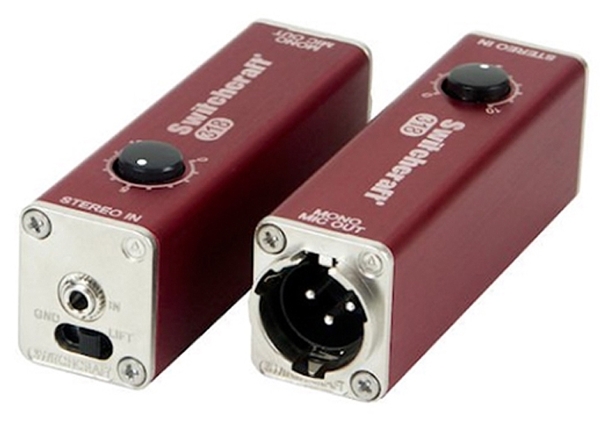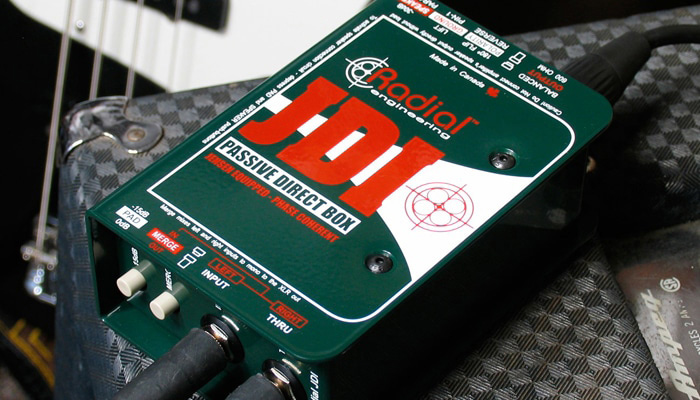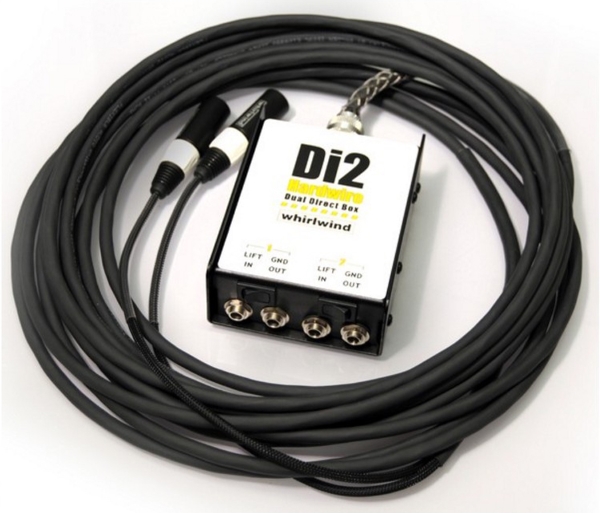In its most basic form, a DI – also known as a direct box and short for “direct injection” and/or “direct insert” – takes an unbalanced high-impedance signal (i.e., from an electric guitar or keyboard) and converts it to a balanced low-impedance signal.
This process is needed when running high-impedance signal at long distances, such as down a snake to a front of house console. Unconverted, the unbalanced signal can pick up noise; also, sending high-impedance signal at longer distances can attenuate higher frequencies.
While there are many basic DI models on the market, there are also several feature-laden versions that do quite a bit more.
Increasing Range
DIs come in two basic varieties: passive and active. Passive designs use a transformer that performs impedance matching and balancing, essentially creating a “magnetic bridge” for audio to pass. They don’t require a battery or phantom power. Sound quality basically depends on the quality of the transformer – good ones sound far better than cheap ones. When faced with a hot input signal, passive designs saturate instead of clipping like their active counterparts, resulting in a warmer sound.
In addition, higher-end passive units may use a shielded transformer to help reject any interference from entering the unit. Speaking of interference, a passive DI really shouldn’t be placed atop an instrument amplifier because the amp transformer’s magnetic field can interfere with the magnetic field of the DI’s transformer. Numerous DI models have a ground switch and an output or loop-thru that facilitates connection of the instrument to the stage amplifier.
Active DIs, on the other hand, utilize electronic circuitry that requires power, provided via a battery or more commonly via phantom power from a mixing console. Some studio-type units may require AC power (usually via a “wall-wart”). Active DIs are much like preamplifiers and can also offer features like ground-lift switches, high-pass filters, mono summing, polarity switches, and equalization circuits. Solid-state electronic designs are common in live audio production, but there are some tube DI models that are popular, particularly in studio applications.
When I was a young sound tech, I learned “The Rule” with DIs: Use a passive unit for high-output instruments like electronic keyboards or guitars with powered pickups, and use an active unit for low-output instruments. It’s still a pretty good rule of thumb but is not absolute, as many active models now have input pads to reduce hot signals while many modern passive models work quite well with low-power signals.
Most DIs convert an instrument signal to a balanced mic output, but there are passive and active models that can also convert a loudspeaker output to a low-impedance balanced microphone signal. Some also include things like cabinet modeling and EQ. Newer on the scene are “media-type” DIs designed specifically for use with playback devices like PCs, phones, tablets, and CD players, converting a headphone speaker output or line output with RCA jacks into a balanced mic signal. Some can take a stereo input and sum it to mono, while others forgo the wires altogether and connect via Bluetooth.
DIs also come in many form factors. Single-channel versions are the most popular, but stereo models and even multi-channel rack-mount units are great when dealing with multiple inputs onstage.
Classics & Innovations
When I began working in audio many (many) years ago, sound companies and other users had to build their own DIs because there weren’t many commercially available units. But then as now, Jensen transformers were highly coveted in this application due to a number of factors, chiefly that they sound great. (Jensen is now owned by Radial Engineering.)
Speaking of Radial, with tube models, rack-mount units, Dante and Bluetooth versions, and more to say that Radial has a DI for any application is not hyperbole, but given the company’s track record, they’ll probably continue to turn out innovative designs for an increasing array of uses.
Classic models like the passive JDI and active J48 are ubiquitous on live stages. One unit (of many) that’s more specialized is the active PZ-DI that’s specifically designed for acoustic and orchestral instruments. It allows users to properly match the input impedance to the source to optimize frequency response, dynamics and “feel.”
A cool more recent model is the Di-NET DAN-TX Dante-enabled DI. Equipped with 1/4-inch, RCA and stereo 3.5 mm input jacks, instruments and line level sources can be directly patched to networked audio systems using the Dante protocol. The DAN-TX has stated 24-bit/96 kHz analog-to-digital conversion to provide high audio quality, and a local 3.5 mm headphone output provides the means to quickly test audio.
The Countryman Type 85 was (and still is) so common in production circles that many performance riders simply say “Countryman” instead of DI on the input list. The Type 85 set a standard for rugged construction, often featured in ads that showed trucks driving over the unit with no damage. It has a single-piece extruded case with thick walls and recessed connectors and switches.

The Type 10, which joined the lineup more recently, delivers increased performance with the same rugged construction, with the company stating that it offers the lowest distortion and noise floor of any commercially available DI. Dual-channel versions of both Countryman units are available, each outfitted with a stereo 1/8-inch TRS jack and a pair of RCA inputs in addition to 1/4-inch inputs and thru jacks. They operate from phantom power or a 9-volt battery. While the lineup is limited, the performance is not, with all units designed to work with any input, including loudspeaker level, while the stereo units can perform double duty as media-type DI boxes.
The iconic IMP 2 from Whirlwind just passed a milestone with over 1 million units sold. This passive DI has parallel-wired 1/4-inch input/output jacks, a ground lift switch, and a tough metal enclosure.
Whirlwind’s TRHL transformer is at the heart, and it’s riveted – not glued – to the chassis so it will stay in place when the box gets tossed around (and you know stuff gets tossed around at gigs).
Whirlwind also has a large selection of active and passive DIs, stereo units, and multichannel rack-mount configurations. One that I absolutely love is the Di2 stage snake stereo DI, a version of the Director 2. It’s a 2-channel unit hard-wired to a 15-, 25- or 50-foot stage snake.
Available in a selection of colors, the Di2 makes it easy to wire up a band when several DIs are needed while also eliminating a pile of XLR cables for a clean stage. In addition, Whirlwind offers Medusa Series snakes with XLR inputs along with DIs built into the same stage box, great for situations such as working with a band with a singing instrumentalist who needs a DI as well as a mic.
Additional Options
Noted for its connectors, Switchcraft also presents a DI lineup of both passive and active units with solid construction and recessed switches. On a recent corporate show, I had a chance to use the new 318, a purpose-designed media DI. Part of the AUDIOSTIX compact interface line, the 318 is the width of a D series connector and less than four inches long, and is equipped with an XLR output on one end and a TRS input jack with recessed ground lift switch on the other. A volume control resides on one side.

The unit takes a TRS input (cable included) from the headphone jack of a laptop, tablet, or phone and provides transformer isolation while summing the signal to a balanced mic level mono output. The miniscule size allows placement on a cluttered podium, making it easy to hook up when the presenter brings an unannounced laptop at the last minute. An install version called the 319 replaces the XLR connector with a terminal block set for line level output.
RapcoHorizon has a variety of well-built DI boxes in mono and stereo configurations, as well as a 4-channel rack-mount version called the SL-4. It’s basically four SL-2 single-channel DIs mounted in a single rack space.
Each channel offers a -20 dB pad switch, ground lift switch, and both front and rear inputs/outputs to suit any wiring scheme. In addition, the company’s BLOX Series presents some very compact units, including the LTIGLBLOX with a built-in 2-foot cable terminated with a 1/8-inch TRS male plug that makes connections easier.
Another unit I see fairly consistently is the Peavey Electronics USB-P, an interface between a laptop and the system processor. The USB-P is a playback-only interface that connects to the USB port of a computer and appears as the stereo output device.
Offering transformer-isolated balanced stereo outputs and a ground lift switch, the unit makes it easy to connect a computer to a sound system. It can also sum stereo signal to mono. Peavey also makes more standard DI boxes, including the ADI-Q active direct box with three-band EQ.
Many other manufacturers offer quality choices as well. The key to finding the “right” DI is giving it a listen to make sure it sounds good for your particular application.






















